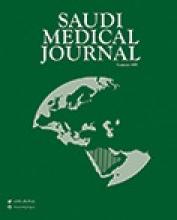Abstract
OBJECTIVE: To study epidemiology including various risk factors incorporated in neonatal necrotizing enterocolitis in Kashmir.
METHODS: A retrospective hospital based study on 3235 neonates admitted in Neonatal Intesive Care Unit of Sheri-Kashmir Institute, were evaluated. Forty two were diagnosed as cases of Neonatal Necrotizing Enterocolitis on the basis of various clinical and radiological parameters and grouped in 3 stages as per modified Bell's classification. The case records of these 42 babies and 303 of the control group were reviewed for the purported risk factors and recorded on pretested proforma and finally statistically analyzed.
RESULTS: Over a period of 10 years, we documented necrotizing enterocolitis in 42 neonates, with an incidence of 1% of all Neonatal Intesive Care Unit admissions and 1% of all live births. Eighty one percent were less than 2000 gms and 76% less than 36 weeks of gestation. Twenty four percent had stage I disease, 33% had stage II, and 43% babies had stage III disease. Multiple risk factors were present in these babies, with significant differences among Necrotizing Enterocolitis and the control group of patients, particularly hypothermia (P<0.001), respiratory distress (P<0.05), polycythemia (P<0.001) acidosis (P<0.01), sepsis (P<0.001), enteral feeding and asphyxia (P<0.001). Of the 59 babies (<2000 gms) with hypothermia (<35oC), 39% developed Necrotizing Enterocolitis, compared to 4% babies (11/278), who did not have hypothermia, statistically a significant finding. Mean birth weight and gestational age were lower than in control group (P<0.05). The age of presentation was 5.2+4.0 days and majority (81%) presented during first week of life, most severe cases presenting earlier than the mild cases. Severity of Necrotizing Enterocolitis as per modified Bell's classification and mortality was inversely related to birth weight and gestational age. One hundred percent mortality was noted in the babies, with birth weight less than 1000 gms and gestational age less than 28 weeks. The overall mortality was 45%, for stage I, 20%; for stage II, 36% and 67% for stage III. Necrotizing Enterocolitis cases accounted for maximum mortality in Neonatal Intesive Care Unit than in control group (P<0.001).
CONCLUSION: Recognition of factors such as prematurity, low birth weight, hypothermia, asphyxia and their timely prevention would help in reducing morbidity and mortality due to Necrotizing Enterocolitis.
- Copyright: © Saudi Medical Journal
This is an open-access article distributed under the terms of the Creative Commons Attribution-Noncommercial-Share Alike 3.0 Unported, which permits unrestricted use, distribution, and reproduction in any medium, provided the original work is properly cited.






